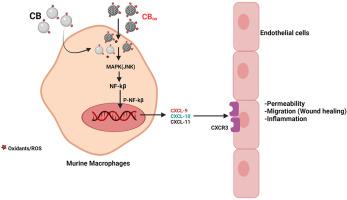Redox Biology ( IF 10.7 ) Pub Date : 2021-10-04 , DOI: 10.1016/j.redox.2021.102161 Nairrita Majumder 1 , Murugesan Velayutham 2 , Dimitrios Bitounis 3 , Vamsi K Kodali 4 , Md Habibul Hasan Mazumder 1 , Jessica Amedro 1 , Valery V Khramtsov 5 , Aaron Erdely 4 , Timothy Nurkiewicz 4 , Philip Demokritou 3 , Eric E Kelley 1 , Salik Hussain 1

|
Oxidation of engineered nanomaterials during application in various industrial sectors can alter their toxicity. Oxidized nanomaterials also have widespread industrial and biomedical applications. In this study, we evaluated the cardiopulmonary hazard posed by these nanomaterials using oxidized carbon black (CB) nanoparticles (CBox) as a model particle.
Particle surface chemistry was characterized by X-ray photo electron spectroscopy (XPS) and Fourier-transform infrared spectroscopy (FTIR). Colloidal characterization and in vitro dosimetry modeling (particle kinetics, fate and transport modeling) were performed. Lung inflammation was assessed following oropharyngeal aspiration of CB or oxidized CBox particles (20 μg per mouse) in C57BL/6J mice. Toxicity and functional assays were also performed on murine macrophage (RAW 264.7) and endothelial cell lines (C166) with and without pharmacological inhibitors. Oxidant generation was assessed by electron paramagnetic resonance spectroscopy (EPR) and via flow cytometry. Endothelial toxicity was evaluated by quantifying pro-inflammatory mRNA expression, monolayer permeability, and wound closure.
XPS and FTIR spectra indicated surface modifications, the appearance of new functionalities, and greater oxidative potential (both acellular and in vitro) of CBox particles. Treatment with CBox demonstrated greater in vivo inflammatory potentials (lavage neutrophil counts, secreted cytokine, and lung tissue mRNA expression) and air-blood barrier disruption (lavage proteins). Oxidant-dependent pro-inflammatory signaling in macrophages led to the production of CXCR3 ligands (CXCL9,10,11). Conditioned medium from CBox-treated macrophages induced significant elevation in endothelial cell pro-inflammatory mRNA expression, enhanced monolayer permeability and impairment of scratch healing in CXCR3 dependent manner.
In summary, this study mechanistically demonstrated an increased biological potency of CBox particles and established the role of macrophage-released chemical mediators in endothelial damage.
中文翻译:

氧化炭黑纳米颗粒通过 CXC 趋化因子受体 3 介导的途径诱导内皮损伤
工程纳米材料在各个工业领域的应用过程中的氧化可能会改变其毒性。氧化纳米材料也具有广泛的工业和生物医学应用。在这项研究中,我们使用氧化炭黑(CB)纳米颗粒(CB ox )作为模型颗粒评估了这些纳米材料造成的心肺危害。
颗粒表面化学通过 X 射线光电子能谱 (XPS) 和傅里叶变换红外光谱 (FTIR) 进行表征。进行了胶体表征和体外剂量测定模型(粒子动力学、命运和传输模型)。在 C57BL/6J 小鼠中口咽吸入 CB 或氧化 CB ox颗粒(每只小鼠 20 μg)后评估肺部炎症。还在使用和不使用药物抑制剂的情况下对小鼠巨噬细胞 (RAW 264.7) 和内皮细胞系 (C166) 进行了毒性和功能测定。通过电子顺磁共振波谱(EPR)和流式细胞术评估氧化剂的产生。通过量化促炎 mRNA 表达、单层通透性和伤口闭合来评估内皮毒性。
XPS 和 FTIR 光谱表明 CB ox颗粒的表面修饰、新功能的出现以及更大的氧化潜力(非细胞和体外)。 CB ox治疗显示出更大的体内炎症潜力(灌洗中性粒细胞计数、分泌细胞因子和肺组织 mRNA 表达)和气血屏障破坏(灌洗蛋白)。巨噬细胞中氧化剂依赖性促炎信号传导导致 CXCR3 配体 (CXCL9,10,11) 的产生。来自CBox处理的巨噬细胞的条件培养基以CXCR3依赖性方式诱导内皮细胞促炎mRNA表达显着升高、单层通透性增强和划痕愈合受损。
总之,本研究从机制上证明了 CB ox颗粒的生物效力增加,并确定了巨噬细胞释放的化学介质在内皮损伤中的作用。











































 京公网安备 11010802027423号
京公网安备 11010802027423号